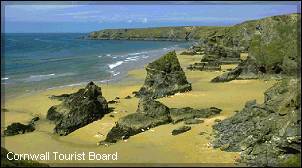|
 Newquay looks back
on 1600 years of history and a dramatic change of identity from fortified
cliff settlement, through tiny port to premier resort. Iron Age Man
smelted ore here for weapons and tools, Industrial Age Man made it his
conduit for the trade in tin and china clay, but Modern man found its
hidden gold; the chain of eleven beaches that have transformed Newquay
in less than a century into the most popular holiday resort in Cornwall. Newquay looks back
on 1600 years of history and a dramatic change of identity from fortified
cliff settlement, through tiny port to premier resort. Iron Age Man
smelted ore here for weapons and tools, Industrial Age Man made it his
conduit for the trade in tin and china clay, but Modern man found its
hidden gold; the chain of eleven beaches that have transformed Newquay
in less than a century into the most popular holiday resort in Cornwall.
Because of its position at the
heart of Cornwall, Newquay makes the perfect touring base to explore
its history and legend. To the north-east is Tintagel where Merlin wove
his spells and King Arthur held court. To the east is Roche Rock, spiritual
home of the Cornish Gorsedd and the wildly beautiful moorland of Bodmin.
And south is the 11th century Restormel Castle, one-time home of the
Black Prince, the beautiful valley of the Fowey and the lushly different
riviera of sleepy estuaries, secluded coves and picturesque fishing
villages like Mevagissey.
Sixteen hundred years ago all that
existed within the modern boundary was a settlement on Porth Island.
You can see a reconstruction of the inhabitants' lifestyle, hunting
and iron-mining methods in the Tunnels Through Time exhibition in St
Michael's Rd. In 1439 Bishop
Lacey of Exeter allowed the burghers of what was then called Towan Blistra
to build a New Quay. It was the beginning of the towns second life as
a fishing port culminating in the arrival of the great pilchard shoals
of the 18th century and the galvanising cry of "Heva !" from the whitewashed
Huer's Hut, still standing above the harbour.
When the pilchards went, the Industrial
Revolution came, turning Newquay from a fishing to a commodity port
loading tin, lead and china clay. The famous six-oared gigs you can
watch in harbour races originally competed to put pilots on board incoming
vessels.  In the seventeen and eighteenth centuries, low wages from
fishing and agriculture were supplemented by smuggling and more sinisterly
the "wrecking" made famous in Daphne du Maurier's Jamaica
Inn. Crantock hid many
a cargo of silks, spices and brandy from the Revenue Men, and wreckers
used to swarm from the villages of St Columb and St Mawgan at news of
a ship in difficulties near the jaws of rock called the Bedruthan Steps. In the seventeen and eighteenth centuries, low wages from
fishing and agriculture were supplemented by smuggling and more sinisterly
the "wrecking" made famous in Daphne du Maurier's Jamaica
Inn. Crantock hid many
a cargo of silks, spices and brandy from the Revenue Men, and wreckers
used to swarm from the villages of St Columb and St Mawgan at news of
a ship in difficulties near the jaws of rock called the Bedruthan Steps.
Cornwall has its own language with
a 2000 year tradition and close ties with Welsh and Breton. As
late as the 18th century peasants resentful of English ways and taxes
would say "My ny vynnaf cows sawnsek" ("I will not speak English"),
but now the language is heard only in bardic revivals of verse or plays
in Plen an Gwary - open-air theatres.
|